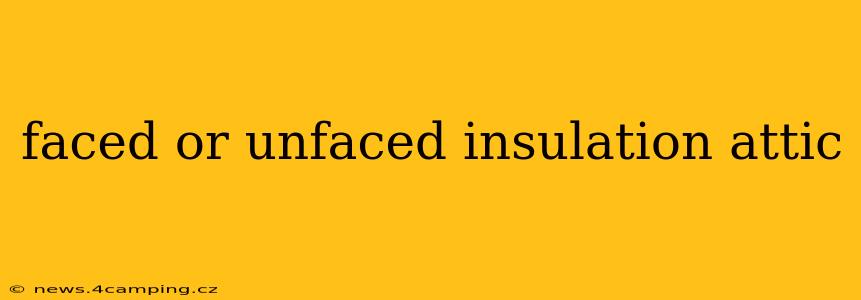Choosing the right insulation for your attic is crucial for energy efficiency, comfort, and long-term cost savings. One of the first decisions you'll face is whether to use faced or unfaced insulation. This comprehensive guide will break down the key differences, helping you make an informed decision for your home.
What is Faced Insulation?
Faced insulation comes with a vapor barrier—a thin layer of material like kraft paper, foil, or polyethylene—attached to one side. This facing provides several benefits, primarily acting as a moisture barrier. It's also often easier to handle and install, particularly in situations where you need to cover larger areas quickly. However, this facing can also affect the insulation's R-value and overall performance.
What is Unfaced Insulation?
Unfaced insulation, as the name suggests, lacks the vapor barrier. This means it requires a separate vapor retarder to be installed during the insulation process. While requiring an extra step, this allows for greater flexibility in choosing the appropriate vapor barrier for your specific climate and attic conditions. It also sometimes offers a slightly higher R-value than its faced counterpart, as the facing material can slightly reduce the insulating properties.
Faced vs. Unfaced Insulation: Key Differences
| Feature | Faced Insulation | Unfaced Insulation |
|---|---|---|
| Vapor Barrier | Integrated | Requires separate vapor retarder installation |
| Ease of Install | Generally easier, especially for larger areas | Can be more challenging, especially for DIYers |
| R-Value | Slightly lower due to facing material | Potentially slightly higher |
| Cost | Often slightly less expensive | Can be slightly more expensive (including vapor barrier) |
| Moisture Resistance | Good, provided the facing is intact and properly installed | Dependent on the quality and proper installation of the separate vapor retarder |
Which Type of Insulation is Best for My Attic?
The best choice between faced and unfaced insulation depends heavily on several factors:
-
Climate: In humid climates, a proper vapor barrier is critical to prevent moisture buildup within the insulation. Faced insulation offers this built-in protection, although a high-quality separate vapor barrier is equally important with unfaced insulation. In drier climates, the need for a vapor barrier is less critical.
-
Existing Vapor Barrier: If your attic already has a vapor barrier, unfaced insulation might be a better choice, allowing you to layer the insulation without compromising on moisture control.
-
DIY vs. Professional Installation: Faced insulation is generally easier for DIY projects. If you're uncomfortable with installing a separate vapor barrier, faced insulation is simpler.
-
Budget: While often cheaper upfront, faced insulation may have a slightly lower R-value impacting energy savings in the long run.
-
Accessibility: For hard-to-reach areas, using unfaced insulation might be more flexible, although this also means needing to ensure the separate vapor barrier is properly installed in those locations.
What are the benefits of using faced insulation in my attic?
Faced insulation offers convenience and built-in moisture protection. Its ease of installation makes it a popular choice for DIY projects and quicker installations. However, remember that the facing material does slightly reduce its R-value compared to unfaced insulation.
What are the benefits of using unfaced insulation in my attic?
Unfaced insulation often provides a slightly higher R-value and greater flexibility in choosing the vapor retarder best suited to your specific climatic conditions. This allows for better customization of your attic's insulation system. It may also be more durable if it is well-protected by the vapor barrier.
Can I use faced and unfaced insulation together in my attic?
While technically possible, it's generally not recommended to mix faced and unfaced insulation. The differing characteristics can create inconsistencies in moisture control and thermal performance. It's best to stick to a single type of insulation throughout your attic for optimal results.
What is the R-value of faced vs. unfaced insulation?
The R-value varies depending on the thickness and material of the insulation. The facing on faced insulation slightly reduces the overall R-value. However, the difference isn't usually significant, and you should consult the manufacturer's specifications for the exact R-value of the specific insulation product you are considering.
This guide provides a general overview. Always consult with a qualified insulation professional for specific advice tailored to your home and local climate conditions. They can assess your attic's needs and recommend the most energy-efficient and cost-effective solution.
